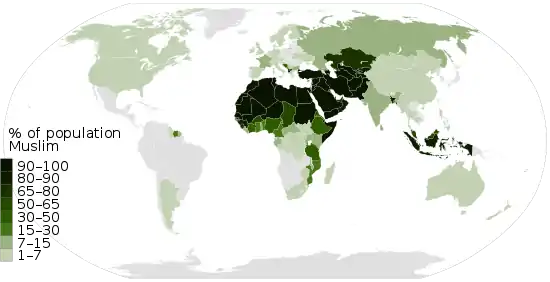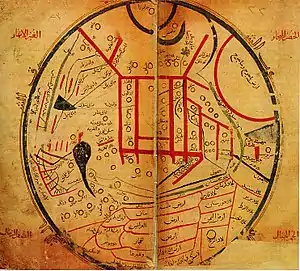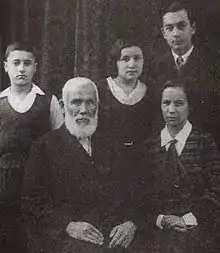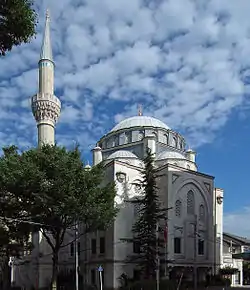Islam in Japan
The history of Islam in Japan is relatively brief in relation to the religion's longstanding presence in other nearby countries. Islam is one of the smallest minority faiths in Japan, having more adherents in the country than the Bahá'í faith, but fewer than Christianity.[1] There were isolated occasions of Muslims in Japan before the 19th century. Today, Muslims are made up of largely immigrant communities, as well as, though smaller, the ethnic Japanese community.[2]
| Islam by country |
|---|
 |
|
|
History
Early history
There are isolated records of contact between Islam and Japan before the opening of the country in 1853, possibly as early as the 1700s; some Muslims did arrive in earlier centuries, although these were isolated incidents.
Medieval records

The earliest Muslim records of Japan can be found in the works of the Muslim cartographer Ibn Khordadbeh, who has been understood by Michael Jan de Goeje to mention Japan as the "lands of Waqwaq" twice: East of China are the lands of Waqwaq, which are so rich in gold that the inhabitants make the chains for their dogs and the collars for their monkeys of this metal. They manufacture tunics woven with gold. Excellent ebony wood is found there.” And: “Gold and ebony are exported from Waqwaq.[3] Mahmud Kashgari's 11th century atlas indicates the land routes of the Silk Road and Japan in the map's easternmost extent.
During that period there was contact between the Hui, general Lan Yu of the Ming dynasty and the swordsmiths of Japan. According to Chinese sources, Lan Yu owned 10,000 Katana, Hongwu Emperor was displeased with the general's links with Kyoto and more than 15,000 people were implicated for alleged treason and executed.[4][5]
Early European accounts of Muslims and their contacts with Japan were maintained by Portuguese sailors who mention a passenger aboard their ship, an Arab who had preached Islam to the people of Japan. He had sailed to the islands in Malacca in 1555.[6][7]
Modern records
The first modern Muslim contacts were with Indonesians who served aboard British and Dutch ships in the late 19th century.
In the late 1870s, the biography of Muhammad was translated into Japanese. This helped Islam spread and reach the Japanese people, but only as a part of the history of cultures.
Another important contact was made in 1890 when Sultan and Caliph Abdul Hamid II of the Ottoman Empire dispatched a naval vessel to Japan for the purpose of saluting the visit of Japanese Prince Komatsu Akihito to the capital of Constantinople several years earlier. This frigate was called the Ertugrul, and was destroyed in a storm on the way back along the coast of Wakayama Prefecture on September 16, 1890. The Kushimoto Turkish Memorial and Museum are dedicated in honor of the drowned diplomats and sailors.
Early 20th century

In the wake of the October Revolution, several hundred Turko-Tatar Muslim refugees from Central Asia and Russia were given asylum in Japan, settling in several main cities and formed small communities. Some Japanese converted to Islam through contact with these Muslims. Historian Caeser E. Farah documented that in 1909 the Russian-born Ayaz İshaki and writer Abdurreshid Ibrahim (1857–1944), were the first Muslims who successfully converted the first ethnic Japanese, when Kotaro Yamaoka converted in 1909 in Bombay after contacting Ibrahim and took the name Omar Yamaoka.[8] Yamaoka became the first Japanese to go on the Hajj. Yamaoka and Ibrahim were traveling with the support of nationalistic Japanese groups like Black Dragon Society (Kokuryūkai). Yamaoka in fact had been with the intelligence service in Manchuria since the Russo-Japanese war. His official reason for traveling was to seek the Ottoman Sultan and Caliph's approval for building a mosque in Tokyo. This approval was granted in 1910. The Tokyo Mosque, was finally completed on 12 May 1938, with generous financial support from the zaibatsu. Its first imams were Abdul-Rashid Ibrahim and Abdülhay Kurban Ali (Muhammed-Gabdulkhay Kurbangaliev) (1889–1972). However, Japan’s first mosque, the Kobe Mosque was built in 1935, with the support of the Turko-Tatar community of traders there.[9] On 12 May 1938, a Mosque was dedicated in Tokyo.[10] Another early Japanese convert was Bunpachiro Ariga, who about the same time as Yamaoka went to India for trading purposes and converted to Islam under the influence of local Muslims there, and subsequently took the name Ahmed Ariga. Yamada Toajiro was for almost 20 years from 1892 the only resident Japanese trader in Constantinople.[11] During this time he served unofficially as consul. He converted to Islam, and took the name Abdul Khalil, and made a pilgrimage to Mecca on his way home.
Japanese nationalists and Islam

In the late Meiji period, close relations were forged between Japanese military elites with an Asianist agenda and Muslims to find a common cause with those suffering under the yoke of Western hegemony.[12] In 1906, widespread propaganda campaigns were aimed at Muslim nations with journals reporting that a Congress of religions was to be held in Japan where the Japanese would seriously consider adopting Islam as the national religion and that the Emperor was at the point of becoming a Muslim.[13]
Nationalistic organizations like the Ajia Gikai were instrumental in petitioning the Japanese government on matters such as officially recognizing Islam, along with Shintoism, Christianity and Buddhism as a religion in Japan, and in providing funding and training to Muslim resistance movements in Southeast Asia, such as the Hizbullah, a resistance group funded by Japan in the Dutch Indies. The Greater Japan Muslim League (大日本回教協会, Dai Nihon Kaikyō Kyōkai) founded in 1930, was the first official Islamic organisation in Japan. It had the support of imperialistic circles during World War II, and caused an "Islamic Studies Book".[14] During this period, over 100 books and journals on Islam were published in Japan. While these organizations had their primary aim in intellectually equipping Japan's forces and intellectuals with better knowledge and understanding of the Islamic world, dismissing them as mere attempts to further Japan's aims for a "Greater Asia" does not reflect the nature of depth of these studies. Japanese and Muslim academia in their common aims of defeating Western colonialism had been forging ties since the early twentieth century, and with the destruction of the last remaining Muslim power, the Ottoman Empire, the advent of hostilities in World War II and the possibility of the same fate awaiting Japan, these academic and political exchanges and the alliances created reached a head. Therefore, they were extremely active in forging links with academia and Muslim leaders and revolutionaries, many of whom were invited to Japan.
Shūmei Ōkawa, by far the highest-placed and most prominent figure in both Japanese government and academia in the matter of Japanese-Islamic exchange and studies, managed to complete his translation of the Qur'an in prison, while being prosecuted as an alleged class-A war criminal by the victorious Allied forces for being an 'organ of propaganda'.[15] Charges were dropped for his erratic behaviour officially; however historians have speculated that the weakness of the charges against him was more likely the true reason. While Okawa did display unusual behaviour during the trial such as rapping on the head of Hideki Tōjō, he also stated that the trial was a farce and unworthy of being called one. He was transferred to a hospital on official claims of mental instability and then prison, and freed not long thereafter, dying as Muslim in 1957 after a quiet life where he continued lecturing, on his return to his home village and his wife, who survived him. He claimed to have seen visions of Muhammad in his sleep.
Post–World War II
The Turks have been the biggest Muslim community in Japan until recently.[16] The Japanese invasion of China and South East Asian regions during the Second World War brought the Japanese in contact with Muslims. Those who converted to Islam through them returned to Japan and established in 1953 the first Japanese Muslim organisation, the "Japan Muslim Association", which was officially granted recognition as a religious organization by the Japanese government in June 1968.[9] The second president of the association was the Umar Mita, who was typical of the old generation, learning Islam in the territories occupied by the Japanese Empire. He was working for the Manshu Railway Company, which virtually controlled the Japanese territory in the northeastern province of China at that time. Through his contacts with Chinese Muslims, he became a Muslim in Peking. When he returned to Japan after the war, he made the Hajj, the first Japanese in the post-war period to do so. He also made a Japanese translation of the Qur'an from a Muslim perspective for the first time. Aljazeera also made a documentary regarding Islam and Japan called "Road to Hajj – Japan".[17]
The economic boom in the country in the 1980s saw an influx of immigrants to Japan, including from majority Muslim nations. These immigrants and their descendants form the majority of Muslims in the country. Today, there are Muslim student associations at some Japanese universities.[9]
In 2016, Japan accepted 0.3% of refugee applicants, many of whom are Muslims.[18]
Muslim demographics
In 1941, one of the chief sponsors of the Tokyo Mosque asserted that the number of Muslims in Japan numbered 600, with just three or four being native Japanese.[10] Some sources state that in 1982 the Muslims numbered 30,000 (half were natives).[8] Of the ethnically Japanese Muslims, the majority are thought to be ethnic Japanese women who married immigrant Muslims who arrived during the economic boom of the 1980s, but there are also a small number of intellectuals, including university professors, who have converted.[19][9] Most estimates of the Muslim population give a range around 100,000 total.[8][9][20] Islam remains a minority religion in Japan, and there is no evidence as to whether its numbers are increasing. Conversion is more prominent among young ethnic Japanese married women, as claimed by The Modern Religion as early as the 1990s.[19]
The true size of the current Muslim population in Japan remains a matter of speculation. Japanese scholars such as Hiroshi Kojima of the National Institute of Population and Social Security Research and Keiko Sakurai of Waseda University suggest a Muslim population of around 70,000, of which perhaps 90% are resident foreigners and about 10% native Japanese.[2][9] Of the immigrant communities, in order of population size, are Indonesians, Indians, Pakistanis and Bangladeshis.[9] The Pew Research Center estimated that there were 185,000 Muslims in Japan in 2010.[21] For 2019 it was estimated that the numbers rose to 230,000, due to the more friendly policies towards immigration, the Japanese converts being estimated at around 50,000, and Japan now has more than 110 mosques compared to 24 in 2001.[22]
Mosques
 Kobe Mosque, Japan's first mosque, built in Indo-Islamic style in 1935 by Jan Josef Švagr
Kobe Mosque, Japan's first mosque, built in Indo-Islamic style in 1935 by Jan Josef Švagr Tokyo Mosque, Japan's largest mosque
Tokyo Mosque, Japan's largest mosque
According to japanfocus.org, as of 2009 there were 30 to 40 single-story mosques in Japan plus another 100 or more apartment rooms set aside for prayers in the absence of more suitable facilities. 90% of these mosques use the 2nd floor for religious activities and the first floor as a halal shop (imported food; mainly from Indonesia and Malaysia), due to financial problems, as membership is too low to cover the expenses. Most of these Mosques have only a capacity of 30 to 50 people. [23]
Notable Muslims
See also
Notes
- https://www.waseda.jp/top/en/news/53405
- Yasunori, Kawakami; JapanFocus.org (May 30, 2007). "Local Mosques and the Lives of Muslims in Japan". JapanFocus.org. Retrieved 27 December 2008.
- Saudi Aramco World: The Seas of Sindbad, Paul Lunde
- (二十六年二月,錦衣衛指揮蔣瓛告玉謀反,下吏鞫訊。獄辭雲:「玉同景川侯曹震、鶴慶侯張翼、舳艫侯硃壽、東莞伯何榮及吏部尚書詹徽、戶部侍郎傅友文等謀為變,將伺帝出耤田舉事。」獄具,族誅之。列侯以下坐黨夷滅者不可勝數。手詔佈告天下,條列爰書為《逆臣錄》。至九月,乃下詔曰:「藍賊為亂,謀泄,族誅者萬五千人。自今胡黨、藍黨概赦不問。」胡謂丞相惟庸也。於是元功宿將相繼盡矣。凡列名《逆臣錄》者,一公、十三侯、二伯。葉升前坐事誅,胡玉等諸小侯皆別見。其曹震、張翼、張溫、陳桓、硃壽、曹興六侯,附著左方。)
- Others implicated in the Lan Yu Case include: Han Xun (韓勛), Marquis of Dongping (東平侯); Cao Tai (曹泰), Marquis of Xuanning (宣寧侯); Cao Xing (曹興), Marquis of Huaiyuan (懷遠侯); Ye Sheng (葉升), Marquis of Jingning (靖寧侯); Cao Zhen (曹震), Marquis of Jingchuan (景川侯); Zhang Wen (張溫), Marquis of Huining (會寧侯); Chen Huan (陳桓), Marquis of Puding (普定侯); Zhang Yi (張翼), Marquis of Heqing (鶴慶侯); Zhu Shou (朱壽), Marquis of Zhulu (舳艫侯); Chahan (察罕), Marquis of Haixi (海西侯); Sun Ke (孫恪), Marquis of Quanning (全寧侯); He Rong (何榮), Count of Dongguan (東莞伯); Sang Jing (桑敬), Count of Huixian (徽先伯)
- "Islam In Japan". Islamic Japanese. Retrieved 2013. Check date values in:
|access-date=(help) - Asia in the Making of Europe, Volume I: The Century of Discovery. - Donald F. Lach - Google Books
- E. Farah, Caesar (25 April approximately 600, 2003). Islam: Beliefs and Observations. Barron's Educational Series; 7th Revised edition. ISBN 978-0-7641-2226-2. Check date values in:
|date=(help) - Penn, Michael. "Islam in Japan". Harvard Asia Quarterly. Archived from the original on 2 February 2007. Retrieved 28 December 2008.
- R&A No. 890 1943, p. 1
- His memoirs: Toruko Gakan, Tokyo 1911
- Japan's Global Claim to Asia and the World of Islam: Transnational Nationalism and World Power, 1900-1945. S Esenbel. The American Historical Review 109 (4), 1140-1170
- Bodde, Derk. “Japan and the Muslims of China.” Far Eastern Survey, vol. 15, no. 20, 1946, pp. 311–313., www.jstor.org/stable/3021860.
- Most of its produced literature is preserved in the Waseda University Library("Archived copy" (PDF). Archived from the original (PDF) on 2009-03-06. Retrieved 2007-12-06.CS1 maint: archived copy as title (link) Catalogue)
- "Okawa Shumei". Britannica. 20 July 1998. Retrieved 6 March 2017.
- "Islam in Japan". Mission Islam.com. Retrieved 27 December 2008.
- "Road to Hajj — Japan - 26 Nov 09 - Pt 1". YouTube. 26 November 2009. Retrieved 2 May 2010.
- Ekin, Annette. "Lives in limbo: Why Japan accepts so few refugees". Al Jazeera.
- Y. Nakano, Lynne; Japan Times Newspaper (November 19, 1992). "Marriages lead women into Islam in Japan". Japan Times. Retrieved 27 December 2008.
- International Religious Freedom Report 2008 - Japan
- "Table: Muslim Population by Country". Pew Research Center. 27 January 2011. Retrieved 19 March 2017.
- "The number of Muslims in Japan is growing fast". The Economist. 7 January 2021. Retrieved 9 January 2021.
- "JapanFocus". JapanFocus. Archived from the original on February 19, 2009. Retrieved 2 May 2010.
References
- Abu Bakr Morimoto, Islam in Japan: Its Past, Present and Future, Islamic Centre Japan, 1980
- Arabia, Vol. 5, No. 54. February 1986/Jamad al-Awal 1406
- Hiroshi Kojima, "Demographic Analysis of Muslims in Japan," The 13th KAMES and 5th AFMA International Symposium, Pusan, 2004
- Michael Penn, "Islam in Japan: Adversity and Diversity," Harvard Asia Quarterly, Vol. 10, No. 1, Winter 2006
- Keiko Sakurai, Nihon no Musurimu Shakai (Japan's Muslim Society), Chikuma Shobo, 2003
- Esenbel, Selcuk; Japanese Interest in the Ottoman Empire; in: Edstrom, Bert; The Japanese and Europe: Images and Perceptions; Surrey 2000
- Esenbel, Selcuk; Inaba Chiharū; The Rising Sun and the Turkish Crescent; İstanbul 2003, ISBN 975-518-196-2
- A fin-de-siecle Japanese Romantic in Istanbul: The life of Yamada Torajirō and his Turoko gakan; Bull SOAS, Vol. LIX-2 (1996), S 237-52 ...
- Research and Analysis Branch (15 May 1943). "Japanese Infiltration Among the Muslims Throughout the World (R&A No. 890)" (PDF). Office of Strategic Services. U.S. Central Intelligence Agency Library.